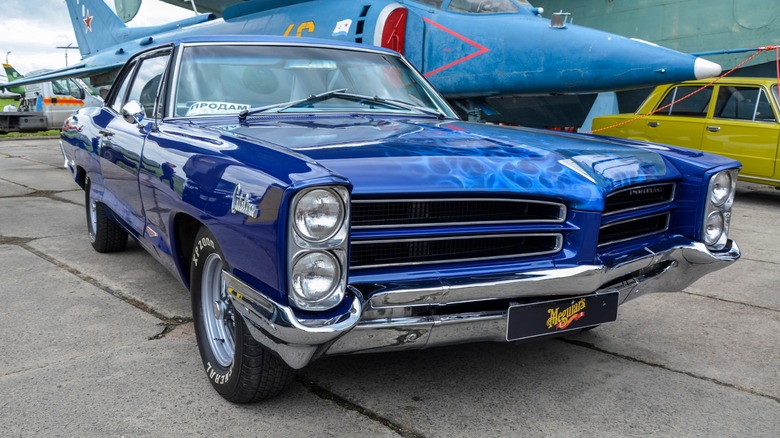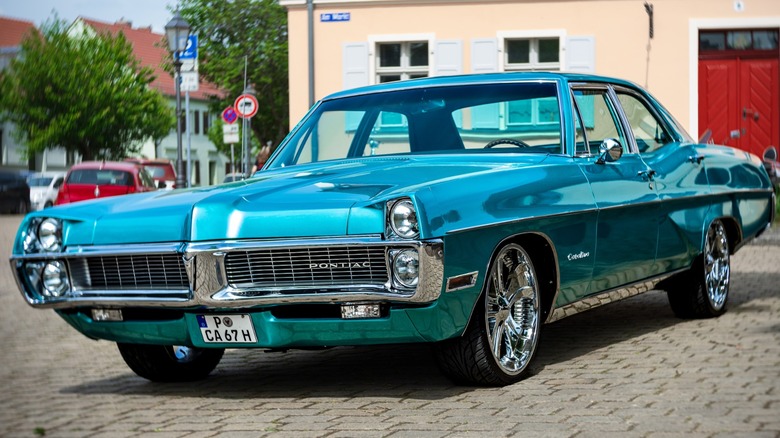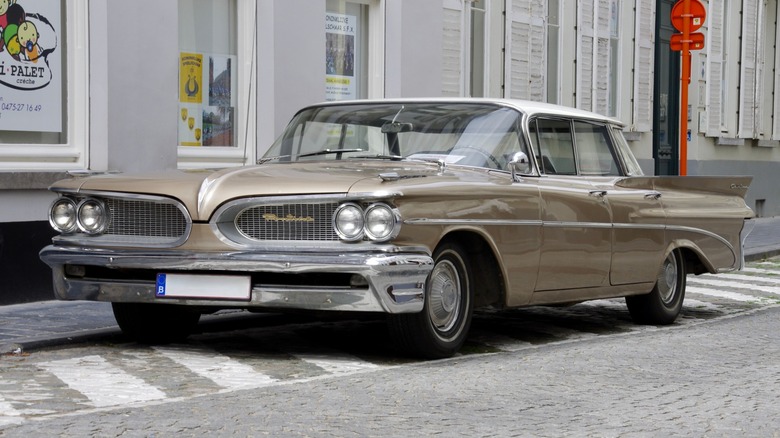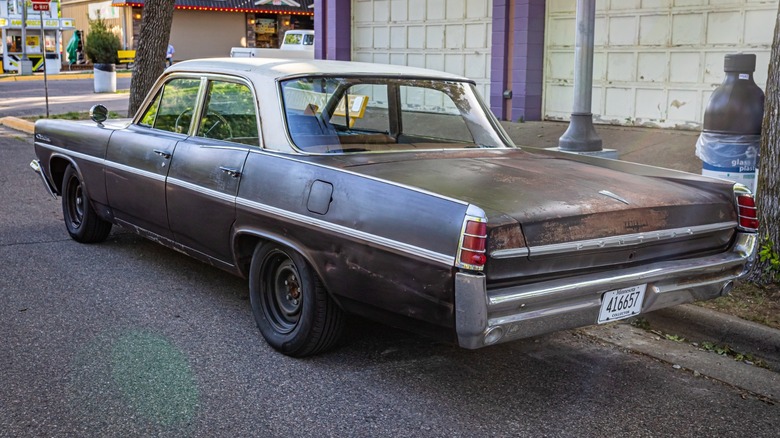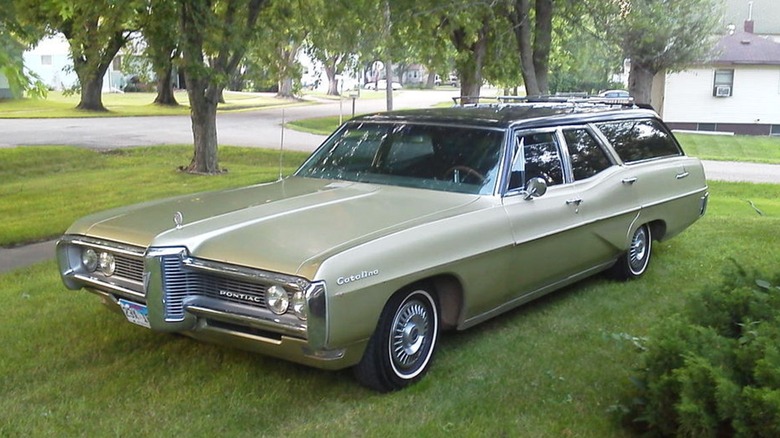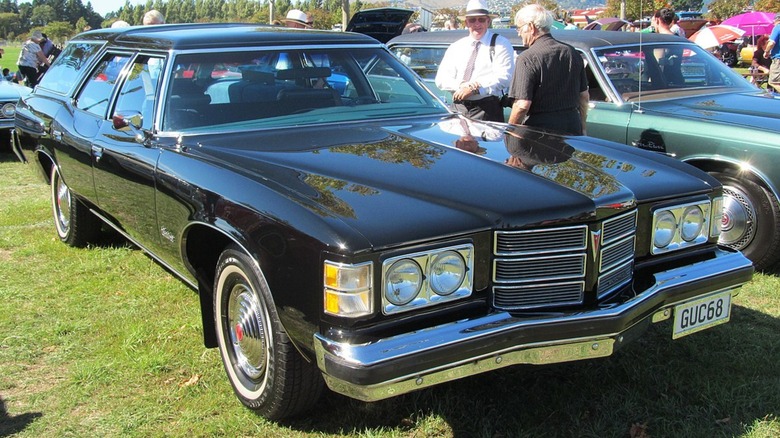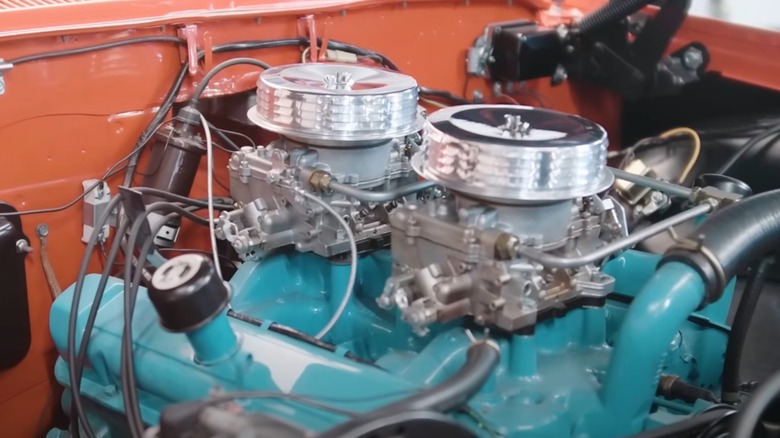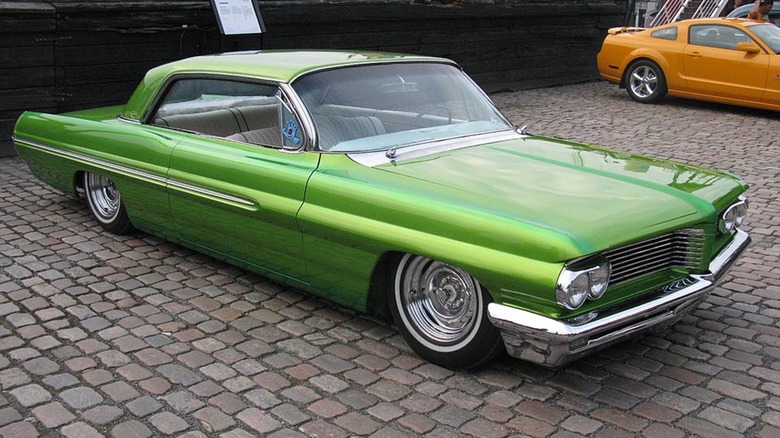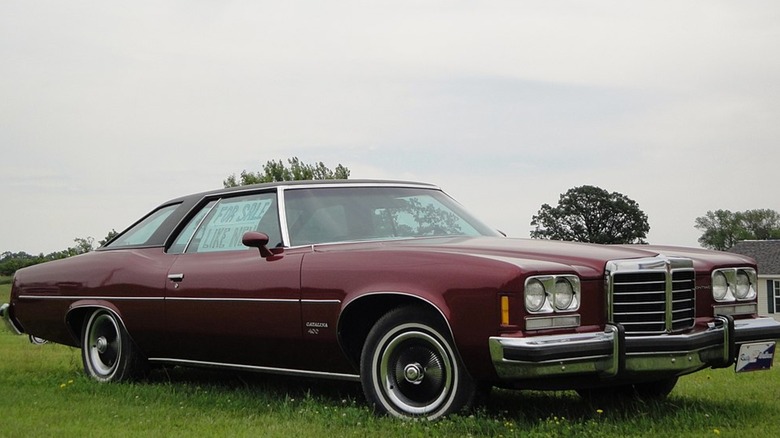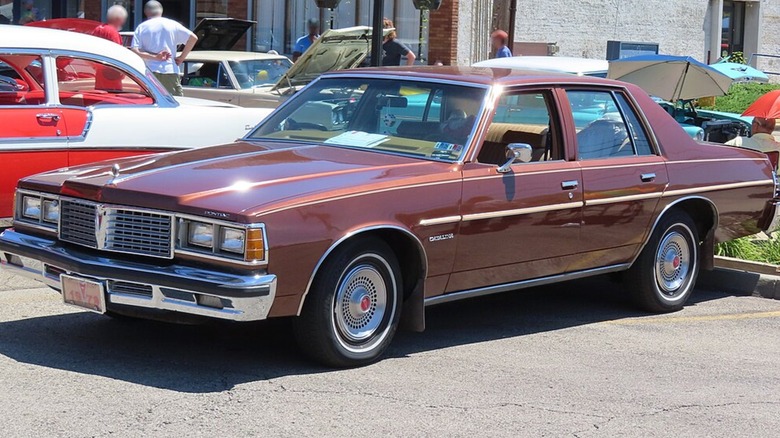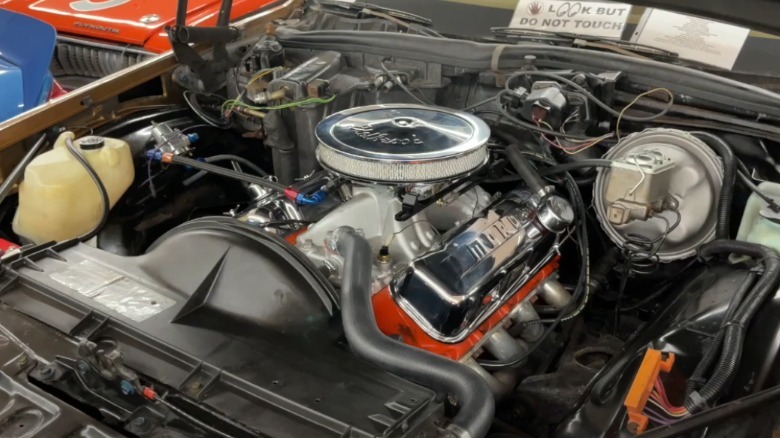9 Reasons A Classic Pontiac Catalina Is Still Worth Buying Today
While it offered a wide range of models over its history, Pontiac only produced the Chieftain and Streamliner in 1950. It was also in 1950 that it offered a trim level of a pillarless two-door hardtop version called Catalina, a name pulled from the island popular as a travel spot off the coast of California. It continued as a trim level until Pontiac released it as a full model in 1959 on a versatile full-size platform, offering the Catalina in sedan, hardtop, convertible, and wagon body styles. The public received the new car warmly, shooting its sales to the top of the Pontiac lineup by 1965. It also emerged as a sort of proto-muscle car by offering the Tri-Power 421 High Output engine, giving the 1962 model 405 hp thanks to a pair of 4-barrel carburetors sitting atop the intake.
Catalina production continued through the 1970s, growing with the times into a portly but comfortable land barge before becoming a victim of downsizing and eventual retirement in 1981. As trends and consumer demands had changed, Pontiac no longer needed two full-size models and elected to move forward with the Bonneville instead. Despite being out of production for more than 40 years, plenty of Catalinas remain available on the used market. With decades of technological advancement since then, Catalinas feature outdated engineering and often basic mechanics, but their style endures and remains compelling today. Therefore, should the look of a classic Catalina pique your interest, these reasons might make one worth buying today.
An unsung hero
Owning a classic car can be highly rewarding. Although it involves a lot of work, the payoff of driving something from another era — a piece of history — can make it worthwhile. The greatest reward often comes in the spontaneous conversations arising from a shared appreciation between strangers and the recognition that your ride is a unique time capsule in a sea of blandly crafted steel. However, the cars that often receive the most praise and attention wear familiar badges such as Mustang, Camaro, GTO, Challenger, etc. While those are great cars with their own appealing traits, a Catalina is different even among classic cars.
Full-size cars may not garner the attention of muscle and sports cars, but depending on what you want out of your vehicle, that should not matter much. Many classic car owners have no desire to race, nor do they need 600 hp of gas-guzzling power. For a daily driver, modest power with good economy is more desirable anyway. Therefore, for someone wanting a nice older car just to cruise and enjoy, a Catalina will do everything it needs to do and look good while doing it. And since Pontiac sold boatloads of them, you'll have no trouble finding the right one. Therefore, a Catalina, something you are unlikely to find on a top 10 list of classic cars, may be the perfect classic car to buy for an ordinary person more interested in driving their car than storing a showpiece in the garage.
An excellent value
Popular classic cars are that ay for a reason, but that also keeps their prices at auctions high. With names like Daytona, Shelby, Corvette, or SS appearing on a badge of a car, you may see winning bids shooting up over the $100,000 mark. Those are fantastic cars, but when you are concerned with maintaining the originality or perfectly preserved condition of what could qualify as a museum piece, daily driving is out of the question. Furthermore, those cars now exist as play toys for the well to do. For average Joes, we have the Catalina.
Online automobile auction site Bring a Trailer lists a wide variety of classic cars, but several Catalinas have sold on the site in recent years for less than $10,000, often in excellent condition. Market tracker Classic shows a couple dozen examples sold for less than $15,000 and as low as $2,500.
If you want one, you can transform and personalize as a project, Facebook Marketplace should have you covered, although the selection can be inconsistent. Finally, if you want a ready-to-drive Catalina, it can easily cost you $30,000, but even that is far more attainable than a $115,000 Shelby Mustang.
Uncomplicated service and repairs
Owning a classic car brings with it a certain number of benefits and challenges, whether it's a rusty 1978 VW Super Beetle or a shiny 1978 Rolls-Royce Silver Shadow. The technology is old and sometimes unreliable as manufacturing at the time may have involved less precision, particularly in production of engine parts. Modern cars are packed with robust, advanced components made on precision assembly lines that ensure longevity. However, more components and systems than ever are packed onto a chassis, creating ever more opportunities for systems to fail, leading to complex and expensive repairs.
On any Catalina model you could buy, all maintenance and repairs are relatively basic. The last models built up to 1981 are the most complex, but still primitive compared to any 2025 model. However, the quality of American cars in the '70s was notoriously poor. Regardless, nearly everything you could want or need to do to any Catalina can be done with a typical mechanic's tool set, although some specialty tools, such as a timing light, will be in order. Furthermore, the amount of room in which to work, particularly under the hood, means everything is accessible and the only job requiring removal of the engine should be replacing the engine itself.
To be clear, classic car ownership is not all puppy dogs and roses. Worn parts and additional maintenance points will require more attention, but you should encounter fewer repairs overall to make you question your own sanity.
Parts and supply
Ownership of any car requires availability of parts. This includes replacements as well as maintenance such as brake pads and ignition points for older models. This issue can even affect new cars – Tesla has had issues with parts shortages in recent years, for example. But for owners of classic cars, sourcing parts can be a reason for worry.
Having a regular supply of parts depends on which model of car you own. For example, owners of an antique Ford Model A, have little to worry as nearly every part is produced today thanks to its continued popularity. Conversely, owners of 996 Porsches of the late '90s are finding its sophisticated and expensive parts in critically short supply.
Fortunately for owners of classic American cars, a steady supply of parts should not pose much of a problem. Multiple companies specializing in either GM or specifically Pontiac parts exist online, with options for new aftermarket or new old stock (NOS) parts and used options. Most of the most common GM components, such as alternators, continue to be widely produced while specialty shops custom build trim and interior pieces. Prices should be reasonable, if not cheap, but alternative parts sources such as swap meets and Facebook Marketplace can also offer excellent savings. Also, you might be surprised how many parts you will find in stock at a local parts store like NAPA, and there is always Amazon, but it is rife with sketchy options, so buyer beware.
Plenty of options
As a trim level in the '50s, all Catalinas were two-door cars with a hardtop, meaning there was no pillar between the front and rear window. This changed with the introduction of the Catalina as a standalone model. In its inaugural year, buyers had the choice of six Catalina body styles in total, offering numerous ways to order exactly the right car for their needs and tastes.
In 1959 and continuing into the 1960s, Catalina body styles included convertible, Safari wagon, two-door coupe and hardtop, and four-door sedan and hardtop. Those living in the South or on a coast might appreciate the wide open space of a hardtop while those in the North might want the extra sealing and insulation for the pillars between the windows. Otherwise, the choice is probably more about personal taste.
Pontiac continued offering multiple body styles through 1970 and pared the option down for the 1971 redesign. In 1971, the convertible was dropped, and the wagon became its own model, the Pontiac Safari. In 1974, the Catalina Safari wagon returned. For the final iteration in 1977, the Pontiac catalog only displayed a Catalina sedan and Catalina Safari. No matter which generation of Catalina strikes you, options abound, and if you look hard enough, the perfect Pontiac could be yours.
Own a racing legend
As previously mentioned, Pontiac released a Catalina in 1962 with a hefty power output and plenty of racing potential. Thanks to the Pontiac 421 Super Duty V8, these cars have since become a legend.
Pontiac offered a Super Duty 389 V8 beginning in 1959, offering it across its range of cars. Late in 1961, it was enlarged to a displacement of 421 cubic inches, and with a pair of four-barrel carburetors, Pontiac only sent it out for installation by factory-backed racers. The Super Duty performed so well on the track, it was added as a factory option for 1962 Catalina and Grand Prix models. Its four-bolt main caps, forged steel crankshaft and connecting rods, lightweight forged Mickey Thompson aluminum pistons, and flat-tappet camshaft made it a monster on the strip. Output was rated at 405 horsepower, but some suggest it was much higher.
The Super Duty Catalina was certainly successful on the track, but sales figures remained low. For 1962, only 140 of them left the factory so equipped, making them among the rarest around now. Suggesting an SD Catalina is still worth buying might be an understatement, but they are only for high rollers. The last one to sell at auction in January 2025 brought in $192,500 at a Mecum auction in Florida. So yes, it is worth buying, but that doesn't mean you can.
Consider lowrider potential
While it's a style that may not be for everyone, the Pontiac Catalina makes a perfect candidate for transformation into a lowrider. The extensive modification of cars that sets them low to the ground and adorned with colorful and wildly artistic paint accompanied by ostentatious ornamentation inside and out goes back to the 1940s in southern California, predominantly in Hispanic neighborhoods. Once shunned by "polite society," lowriders have emerged as a car culture as unique and fascinating as the cars themselves.
The base models upon which most lowriders are built are most often large American cars. Coupes, sedans, and convertibles are all fair game, but it seems the longer and lower they are, the better. The boats of the '70s make excellent lowriders, and the Pontiac Catalina of that era fits to the mold like a glove, although any of them will do. And for those who need a bit of space while cruising the strip, a Catalina Safari wagon like the slick lime-colored ride featured in Street Muscle Magazine works as well. The best part of making a lowrider Catalina is that only your imagination – and your pocketbook – constrains you.
It's a ride in comfort
While any year model Catalina is built to offer a smooth and comfortable ride, and those built from 1971 to 1976 offer yards of plush fabric on wide bench seats to ensure it. The land yacht-era of Catalina made for roomy cars riding on pillow-like suspensions geared much more for lazy cruising than a hurried sprint, but sometimes that is just the kind of drive that is called for.
If you have never been in a full-size car, nearly 19-feet long from this era, you might have trouble grasping exactly what the experience is like. Having driven several similar GM cars of this era, I can tell you it is an unusual one. The suspensions are extremely soft, making bumps on the road nearly imperceptible, especially because of the sheer weight of these monstrosities. Furthermore, the power steering is over-boosted, offering no feedback while allowing you to turn the wheel with your pinky.
However, body roll is atrocious and the seats are long flat benches, making fast corners a bit terrifying as the car leans way over while you slide across the vinyl seat toward the passenger door. But heading straight down the highway is totally carefree, and you will never feel short on space. Four people can ride up front and in the rear without feeling cramped, and tall passengers will never complain. These giant cars are not for everyone and parking them is a nightmare, but for some buyers, there's nothing better.
It's the ultimate sleeper
Sleeper cars are custom models built to boast extraordinary power housed in ordinary digs. They are popular with some drivers because of the fun in goading someone in a hot sports car to race what they believe is a family car just to be embarrassed by an extremely fast grocery-getter. Most Pontiac Catalina models could make a good sleeper, but the last generation built from 1977 to 1981 may be the best.
To be clear, the last Catalinas are not the prettiest cars. They probably will never get the attention and the glances that a 1962 or even '72 model will. The GM car design of that period seemed obsessed with straight lines and right angles while grasping onto traditional styling cues for dear life. They are undeniably dull, and that is why they would be a good sleeper.
The engines from late '70s also have no power. However, those Catalinas are compatible with a wide range of engines from Pontiac and other GM divisions, making it easy to slip an early Pontiac 400 under the hood or even do what everyone does to everything, LS swap it. This is purely hypothetical and somewhat of a fantasy, but if you could imagine a 1981 LS Catalina in pristine but stock condition heading out to the midnight drags, you could cause some sweet embarrassment and possibly win a few bets. Less hypothetical is a 1979 model with a 468 Big Block V8 on YouTube that is surely much faster than it looks.
